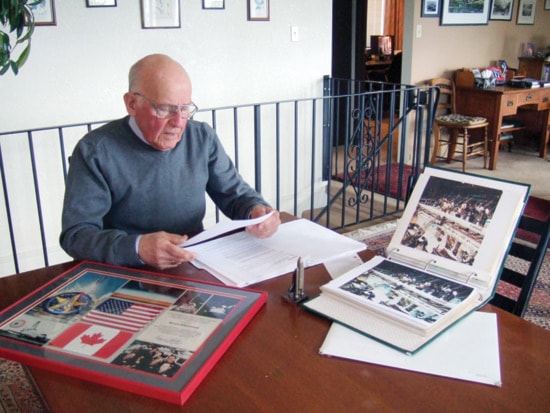The connection was good, the sound clear.
That is how Bruce Aikenhead describes a long-distance call he received in May 2009 – from the International Space Station orbiting high above the Earth, at that moment, just off the west coast of South America.
The caller, astronaut Bob Thirsk, was the same man who had sent Aikenhead emails and a photo of Shuswap Lake taken from outer space.
Thirsk was one of the original seven Canadians chosen to be astronauts, just as the word was being coined by NASA, says Aikenhead, whose accomplishments could fill several books.
“The Russians had ‘cosmonauts,’ so we got astronauts,” says this modest Space pioneer, who, in 1997, was named an officer of the Order of Canada.
The seven Canadian astronauts were chosen in 1983 from around 4,000 hopefuls, who wanted to get in on the ride of a lifetime.
“They wanted people with an engineering background because you can do some very interesting experiments when you’re not hindered by gravity,” he says.
Originally chosen as backup for Bob Garneau, the first Canadian to travel to Space, Aikenhead says Thirsk had been invited to train with the Russians and travel with them to the international space station in 2009.
“We chatted for about five minutes, mostly about the other crew members,” he says of his Space-to-Earth call that was routed through NASA.
As manager of the Canadian Astronaut Project, Aikenhead was well-acquainted with all the early astronauts and says his job with Project Mercury was to familiarize them with what would happen to them in Space, get them down to Houston for training and back to Canada where they were put on parade by the federal government.
Aikenhead’s career was already stellar before he became involved with the “Space Race,” including his work in designing radios, the CF-100 flight simulator with Canadian Aviation Electronics (CAE) in Montreal and a project engineer at NASA’s initial base in Langley, Virginia.
A simulator systems engineer on the famous Avro Arrow in 1958-59, Aikenhead says the aircraft was remarkable and well ahead of its time.
“It’s a shame it was cancelled, it would have put us on the aviation map,” he says, noting he landed the job with the Mercury astronaut training project almost immediately.
“I was just incredibly lucky to be there and available when all these things happened.”
Aikenhead laughs wryly as he explains he left NASA, as did many others, when then-president Lyndon Johnson moved space operations to Texas, telling the employees he would make them all Texans.
This did not sit well with Aikenhead, who returned to CAE industries in Montreal, until he met Gerry Bull, whose work interested and impressed him.
In charge of a joint Canadian and U.S. gun-launched satellite research project, Bull, who became a notorious arms dealer was still on the up-and-up.
“He was brilliant, I think he got a PhD when he was 19,” says Aikenhead. “He was able to do the calculations that if he used very large battleship guns pointed straight up, he could launch projectiles to a very high altitude.”
About 18 months before their first attempt to put the research into practice, the U.S. Navy pulled the plug on the project, with the Canadian government quickly following suit.
Aikenhead walked away from Bull and into another job, while his former colleague turned to dealing in munitions.
While living in Belgium, an illegal arms hotbed, Bull was approached by Saddam Hussein, who wanted “really big” missiles that would be aimed at Israel.
Aikenhead says Bull was eventually killed by Mossad, the Israeli security agency, although this has never been proven.
After a five year stint with RCA where he worked as a systems engineer, in 1976, Aikenhead became supervision-team engineer on the Canadarm. Then it was on to the National Research Council’s Space Vision System for the space shuttle in 1981. His involvement with the Canadian Astronaut Program began in 1984 and he was program director from 1990 until his retirement in 1993 at the age of 69.
Still sharp at 88, Aikenhead enjoys jazz, astronomy and time spent with his family. Of his remarkable career, he says quietly, “what happened was mostly by chance.”
But, refers to one of his favourite quotes, attributed to Louis Pasteur; “Chance favours the informed mind.”
